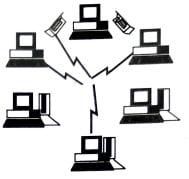Table of Contents
Topology
Network Topology refers to the way in which the stations are physically connected. Network topology defines the manner in which the nodes are geometrically arranged and connected to one another.
Topology defines the physics or logical arrangement of links in a network. In computer network each computer is known as nodes and how these nodes are conncted with each other’s is called the network topology.
Types of Network Topology
There are five types of network topologies that are commonly used. These are
- Mesh Topology
- Star Topology
- Bus Topology
- Ring Topology
- Tree Topology
Mesh Topology
Mesh Topology is also called as complete topology.
In a mesh topology, every device has a dedicated point to point link to other devices where point to point means that only one terminal/wire directly connects only the two devices.
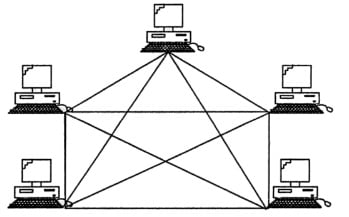
The term dedicated means the link carries traffic only between the two devices it connects. A mesh network has (n (n-1))/2 physical channels to link n devices.
The accommodate that many links; every device on the network work must have (n-1) input-output ports. Mesh topology is employed for long-distance transmission of data between nodes.
Mesh topology is of two types:
- True mesh topology
- Hybrid mesh topology
Advantages of Mesh Topology
- The dedicated link between nodes ensure optimum data rate and eliminated traffic problem.
- Better privacy and security.
- Mesh topology is robust.
- Failure of any link will not cause the failure of the entire network.
- Point-to-point links make fault identification and fault isolation easy.
Disadvantages
- A large amount of cabling and I/O ports are required.
- Hard-ware required for each link (I/O ports) and redundant link increases cost.
- Difficulty In installation.
- Difficult to reconfigure.
Star Topology
In a star topology, each device has a dedicated point-to-point link only to a central controller, usually called a hub. The devices are not directly linked to each other. Unlike a mesh topology, a star topology does not allow direct traffic between devices. The controller acts as an exchange: If one device wants to send data to another, it sends the data to the controller, which then relays the data to the other connected device.
The star is probably the most commonly used topology today. It uses twisted pair cabling and requires that all devices are connected to a hub.
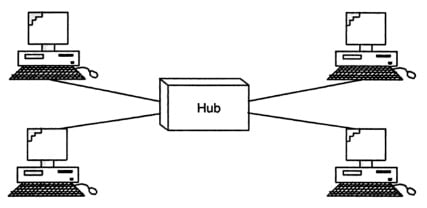
• If a node wants to send data to another node, it sends the data to central hub, which then relays the data to the desired node.
Advantages of Star Topology
- Each device needs only one link and one I/O port makes star topology less expensive, easy to install, and easy to configure.
- Robust topology.
- If any link fails, it does not affect the entire network.
- Easy fault identification and fault isolation.
- It is easy to modify and add new nodes to a star network without disturbing the rest of the network.
Disadvantages
- If the central hub fails, the whole network fails to operate.
- Each device requires its own cable segment.
- In hierarchical network, installation and configuration is difficult.
Bus Topology
It is also called as linear topology. All other topologies (mesh, star, ring) described point-to-point configuration.
A bus topology is multipoint. One long cable acts as a backbone to link all other devices in the network. The speed of the bus topology is slow because only one computer can send a message at a time. A computer must wait until the bus is free before it can transmit.
The bus topology requires a proper termination at both ends of the cable. Since the bus is a passive topology. the electrical signal from a transmitting computer is free to travel the entire length of the cable. Nodes are connected to the bus cable by droplines and taps.
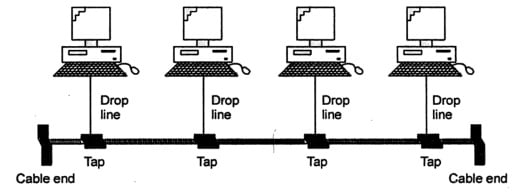
Dropline: A drop line is a connection between the devices and the main cable.
Tap: A tap is a connection that punctures with the metallic core.
Advantages of bus topology
- Bus topology is easy to install.
- Because of backbone, less cable is required.
- Number of I/O port required is less also the hardware is reduced.
- The backbone can be extented by using repeater.
- Cost of the network is low.
Disadvantages
- Heavy network traffic can slow a bus considerably.
- Difficult reconnection and fault isolation (troubleshooting).
- Difficult to add new node/device.
- Signal reflection at the taps can cause degradation in quality.
- Failure of backbone affects failure of all devices on the network.
Ring Topology
It is also called as circular topology. in a ring topology, each device has a dedicated point-to-point line configuration only with the two devices on either aide of it. A signal is passed along the ring in one direction, from device to device, until it reaches its destination. Each device in the ring incorporates a repeater. When a device receives a signal intended for another device, its repeater regenerates the bits and passes them along.
The ring topology looks are the same as the star; except that it uses special hubs and Ethernet adapters. The ring topology is used with Token Ring networks.
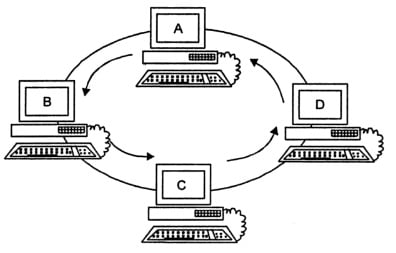
The signal travels along the ring in one direction from device-to-device till it reaches to the destination. In between the signal is regenerated by the repeater in the ring, therefore it is a active network and termination is not required.
Advantages of Ring Topology
- A ring is relatively easy to install and reconfigure.
- Link failure can be easily found as each device is connected to its immediate neighbors only.
- Because every node is given equal access to the token no one node can monopolize the network.
Disadvantages
- The maximum ring length and number of devices is limited.
- Failure of one node on the ring can affect the entire network.
- Adding or removing nodes disrupts the network.
Tree Topology
It is also called as hierarchical topology. A tree topology is a variation of a star. As in a star, nodes in a tree are linked to a central hub that controls the traffic to the network.
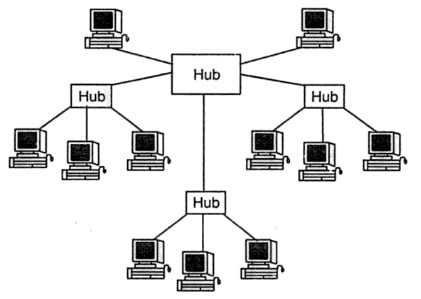
However not every computers plugs into the central hub, majority of them are connected to a secondary hub which in turn is connected to the central hub as shown in above figure.
The central hub in the tree is an active hub, which contains repeater. The repeater amplifies the signal and increase the distance a signal can travel. The secondary hubs may be active or passive. A passive hub provides a simple physical connection between the attached devices.
Tree Topology is somewhat similar to bus topology. We can say that tree topology is another form of bus topology. But unlike bus topology, the nodes in a tree extend similar to the branches of a tree with the trunk or we can say bus is a special case of tree in which there is only one trunk.
Advantages of Tree Topology
- It allows more devices to be attached to a single hub and can therefore increase the distance of a signal that can travel between devices.
- It allows the network to isolate and prioritize communications from different computers.
Disadvantages of Tree Topology
- If the central hub fails the system breaks down.
- The cabling cost is more.
Note: The advantages and disadvantages of a tree topology are generally the same as those of a star.
Related Post:

